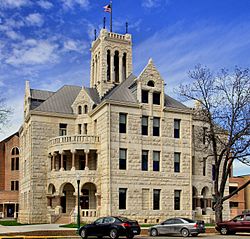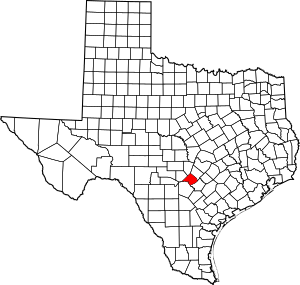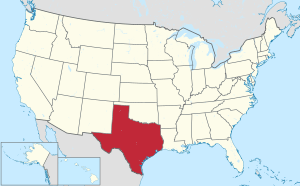Comal County, Texas facts for kids
Quick facts for kids
Comal County
|
||
|---|---|---|

The 3.5 story Romanesque Revival style Comal County Courthouse in New Braunfels was built in 1898.
|
||
|
||

Location within the U.S. state of Texas
|
||
 Texas's location within the U.S. |
||
| Country | ||
| State | ||
| Founded | 1846 | |
| Seat | New Braunfels | |
| Largest city | New Braunfels | |
| Area | ||
| • Total | 575 sq mi (1,490 km2) | |
| • Land | 559 sq mi (1,450 km2) | |
| • Water | 15 sq mi (40 km2) 2.7% | |
| Population
(2020)
|
||
| • Total | 161,501 | |
| • Density | 288.9/sq mi (111.5/km2) | |
| Time zone | UTC−6 (Central) | |
| • Summer (DST) | UTC−5 (CDT) | |
| Congressional districts | 21st, 35th | |
Comal County (pronounced KOH-mal) is a county located in the U.S. state of Texas. It's known for its interesting German-Texan and European history. The main city and county seat is New Braunfels.
Comal County is part of the larger San Antonio-New Braunfels area. It is one of the fastest-growing counties in the United States! In 2017, Comal County was the second-fastest growing county in the nation. This means many new homes are being built, and more people are moving here. This growth also means more traffic and a greater need for public services like schools and parks.
Contents
History of Comal County
The land that is now Comal County was first home to Native American tribes. These included the Tonkawa, Waco, Karankawa, and Lipan Apache people.
Around the early 1700s, the area became known as "Comal." This is a Mexican Spanish word for "flat griddle." In 1825, a large piece of land around Comal Springs was given to Juan Martín de Veramendi.
German Settlers Arrive
In 1842, a group called the Adelsverein was formed in Germany. Their goal was to help Germans move to Texas. A huge land grant was set aside to settle many families from Germany, the Netherlands, Switzerland, Denmark, Sweden, and Norway.
In 1845, Prince Carl of Solms-Braunfels bought land for the Adelsverein. This land included the Comal Springs and River. Thousands of German immigrants arrived in Texas, but many faced very tough conditions. They were stranded without enough food or shelter, and many became sick.
About 200 German colonists walked from the coast to find the town of New Braunfels. They settled near the Guadalupe River. In March 1846, the Texas government officially created Comal County. New Braunfels became its county seat.
Growing as a Community
By 1850, a survey of German farms in Comal County showed they did not use enslaved workers. In 1852, the Neu-Braunfelser Zeitung newspaper began publishing, first only in German.
In 1854, the county was divided into eight public school districts. The Texas State Convention of Germans met and discussed important ideas. They supported equal pay, direct election of the U.S. President, and free schools. They also believed that slavery was wrong and should be ended.
The county's final borders were set in 1858. During the American Civil War, Comal County voted to leave the Union. It sent three all-German volunteer companies to fight for the Confederate side.
Modern Developments
Later, in 1887, the Faust Street Bridge was built over the Guadalupe River. The beautiful Comal County Courthouse was built in 1898. In the 1920s, Comal County became a center for making and shipping textiles, clothes, flour, and building materials.
In 1960, four students discovered Natural Bridge Caverns. These are the largest known commercial caves in Texas! In 1961, the first "Wurstfest" was held, attracting many visitors. In 1964, Canyon Lake was created, which greatly boosted tourism in the area.
Darmstadt Society of Forty
The Adelsverein also worked with another group called the Darmstadt Society of Forty. This group tried to start several colonies in Texas, including one called Darmstädler Farm in Comal County. They were supposed to get money, animals, and supplies. However, most of these colonies did not last. Only Castell still exists today. The colonies failed because their funding ran out and there were disagreements about how they should be run. Some members moved to other German settlements in Texas.
Geography
Comal County covers about 575 square miles. About 15 square miles of this area is covered by water.
The Balcones Escarpment is a major land feature that runs through the county. West of this escarpment, you'll find the rocky hills and canyons of the Texas Hill Country. To the east, there are flat grasslands.
The Guadalupe River flows through the county and forms Canyon Lake. The Comal River starts from the Comal Springs in New Braunfels and quickly joins the Guadalupe River.
Neighboring Counties
Comal County shares borders with these other counties:
- Hays County (north)
- Blanco County (northwest)
- Guadalupe County (southeast)
- Bexar County (southwest)
- Kendall County (west)
Getting Around
Main Roads
 Interstate 35
Interstate 35 U.S. Highway 281
U.S. Highway 281 State Highway 46
State Highway 46
Airports
- New Braunfels
- Spring Branch (Kestrel)
Population Information
| Historical population | |||
|---|---|---|---|
| Census | Pop. | %± | |
| 1850 | 1,723 | — | |
| 1860 | 4,030 | 133.9% | |
| 1870 | 5,283 | 31.1% | |
| 1880 | 5,546 | 5.0% | |
| 1890 | 6,398 | 15.4% | |
| 1900 | 7,008 | 9.5% | |
| 1910 | 8,434 | 20.3% | |
| 1920 | 8,824 | 4.6% | |
| 1930 | 11,984 | 35.8% | |
| 1940 | 12,321 | 2.8% | |
| 1950 | 16,357 | 32.8% | |
| 1960 | 19,844 | 21.3% | |
| 1970 | 24,165 | 21.8% | |
| 1980 | 36,446 | 50.8% | |
| 1990 | 51,832 | 42.2% | |
| 2000 | 78,021 | 50.5% | |
| 2010 | 108,472 | 39.0% | |
| 2020 | 161,501 | 48.9% | |
| 2023 (est.) | 193,928 | 78.8% | |
| U.S. Decennial Census 1850–2010 2010 2020 |
|||
As of the 2020 census, Comal County had a population of 161,501 people. The county has grown a lot over the years. In 2010, there were 108,472 people living here.
Most people in Comal County are White. The number of people who identify as Hispanic or Latino has also increased significantly. The county is becoming more diverse.
In 2010, about 25.5% of the population was under 18 years old. The average age was 39 years. Most households were made up of married couples living together.
Communities
Comal County has several cities and towns. Some cities are so big they are in more than one county!
Cities (in multiple counties)
- Fair Oaks Ranch (also in Bexar and Kendall counties)
- New Braunfels (county seat, mostly in Comal but also in Guadalupe County)
- San Antonio (mostly in Bexar County and a small part in Medina County)
- Schertz (also in Guadalupe and Bexar counties)
- Selma (mostly in Bexar and Guadalupe counties)
Cities (only in Comal County)
Census-designated place
- Canyon Lake
Other Communities
These are smaller towns and areas that are not officially cities:
- Bracken
- Canyon City
- Comal
- Fischer
- Hunter
- Sattler
- Smithson Valley
- Solms
- Startzville
Ghost Towns
Some places in Comal County used to be towns but are now abandoned or have very few people. These are called ghost towns:
- Anhalt
- Cranes Mill
- Dittlinger
- Freiheit
- Gruene
- Honey Creek
- Oak Cliff Acres
- Ogden
- Royal Forest
- Silver Hills
- Valley View
- Wesson
Education
Students in Comal County attend schools in several different school districts:
- Boerne Independent School District
- Comal Independent School District
- New Braunfels Independent School District
- Wimberley Independent School District
For higher education, the entire county is served by the Alamo Community College District.
See also
 In Spanish: Condado de Comal para niños
In Spanish: Condado de Comal para niños


